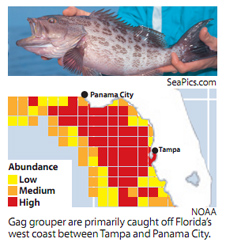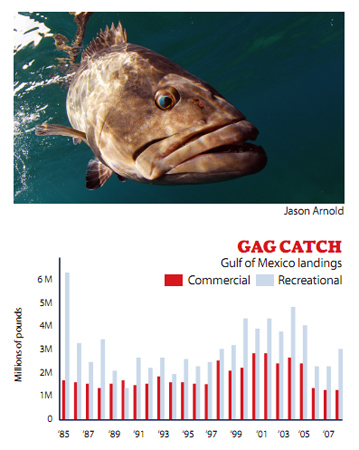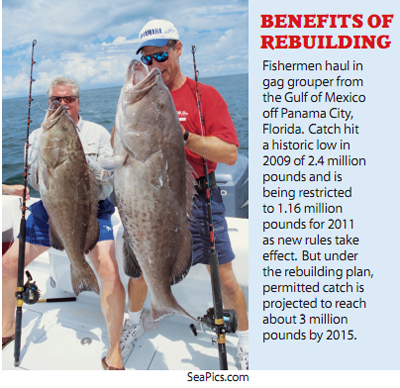A Plan to Save Gag Grouper
 If you think of a mouthwatering fish sandwich, it may be gag grouper. But since 2004, the population has been sliced nearly in half. A recovery plan can help this species rebound. It calls for a shorter recreational fishing season, reduced commercial catch, and other protections. But those rules could be relaxed as gag grouper show signs of recovery.
If you think of a mouthwatering fish sandwich, it may be gag grouper. But since 2004, the population has been sliced nearly in half. A recovery plan can help this species rebound. It calls for a shorter recreational fishing season, reduced commercial catch, and other protections. But those rules could be relaxed as gag grouper show signs of recovery.
Signs of Decline
Gag grouper are:
- At about 40 percent of a minimum healthy population level
- Fished at more than 2.5 times the sustainable rate
- Predominantly female; they outnumber males 30 to 1, leaving fewer breeders
- Easily caught and found in well-known spawning grounds
- Frequently caught and killed by accident when fishermen target other species
- In further decline after 1 in 5 gag died in 2005 in the wake of a major red tide
2010 Rules
- Annual catch allowed: commercial, 1.49 million pounds; recreational, 2.14 million pounds
- Two gag per person per recreational fishing trip
- Size limit: 24 inches, commercial; 22 inches, recreational
- Recreational fishing season closed February and March
- All grouper species limited to four fish per person per fishing trip
- Quota program limits the number of commercial fishermen and caps the amount each can keep
2011 Temporary Rules*
- Commercial quota at 430,000 pounds to allow for accidental catch
- Recreational target of 620,000 pounds. Recreational fishing open Sept. 16 to Nov. 15. Florida rules in line with federal rules
* Enacted pending approval of long-term plan
Long-Term Recovery Plan
New Rules Begin in 2012
- Recreational fishing open July 1 through Oct. 31
- Annual permitted commercial catch for 2012, 567,000 pounds; 2013, 708,000 pounds; 2014, 835,000; 2015, 939,000 pounds
- Annual targeted recreational catch for 2012, 1.031 million pounds; 2013, 1.287 million pounds; 2014, 1.519 million pounds; 2015, 1.708 million pounds
- Increases in catch limits contingent upon staying with prescribed quotas
- Annual changes in quotas and other rule adjustments, such as length of the fishing season, may be necessary to maintain catch at prescribed levels
- Commercial size limit reduced from 24 to 22 inches
- Maintains 22-inch recreational minimum size limit; keeps daily limit of two gag and four total grouper
Gag Grouper's Troubles
 Population Decline
Population Decline
The gag grouper population has been sliced nearly in half since 2004 and is at about 40 percent of a minimum healthy level. The fish have been caught at more than 2.5 percent of a minimum healthy level. The fish have been caught at more than 2.5 times the sustainable rate. In the past, only a small portion of spawning habitat was protected and a lack of scientifically sound fishing limits contributed to the species' decline.
Missing Males
Male gags have dropped from as high as 17 percent of the population in the 1970s to as low as 2 percent since the 1990s, leaving fewer breeders. Gag are protogynous hermaphrodites, meaning all start as female and some develop into males at 11 years old or about 43 inches. Overfishing has snared many females that might potentially turn into males and has thrown the natural process out of balance. Heavy fishing at spawning areas also further depletes males.
Easy Targets
Gag are a popular target in part because they are easily found. Some smaller fish remain close to shore or live near artificial reefs and rocky bottoms. While females move between shallower and deeper waters, the bigger males reside at limerock outcroppings on the deep seafloor year-round. Commercial fishermen target these deeper spots and spawning areas. Aggressive males eagerly feed on bait and are readily caught.
 |
Red Tide Fallout
In a major 2005 red tide, an algal bloom that released a potent neurotoxin swept through areas where gag and many other fish species live. About 1 in 5 gag died after that event, adding to the deaths that normally occur from fishing and natural causes—a dramatic impact on the population and reproduction.
Accidental Catch
Too many gag grouper die after being thrown back when they are not legal to keep or are caught accidentally by fishermen targeting other species. A higher percentage of gag die after being caught and released in deeper waters, making it difficult for gag to survive the rapid change in water pressure. Reducing accidental catch is an important component of ensuring sustainable fisheries in the Southeast, and additional research is needed to identify tools and techniques to address this issue.
How You Can Help
Visit www.PewEnvironment.org/Gulffish to learn more and join our e-alert network. Contact Sharon McBreen at [email protected] or 321.800.6313 to sign up for fish news or join our cause. For information, contact project leader Holly Binns at [email protected] or 850.727.8241.








